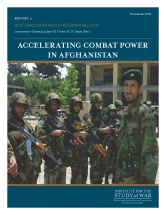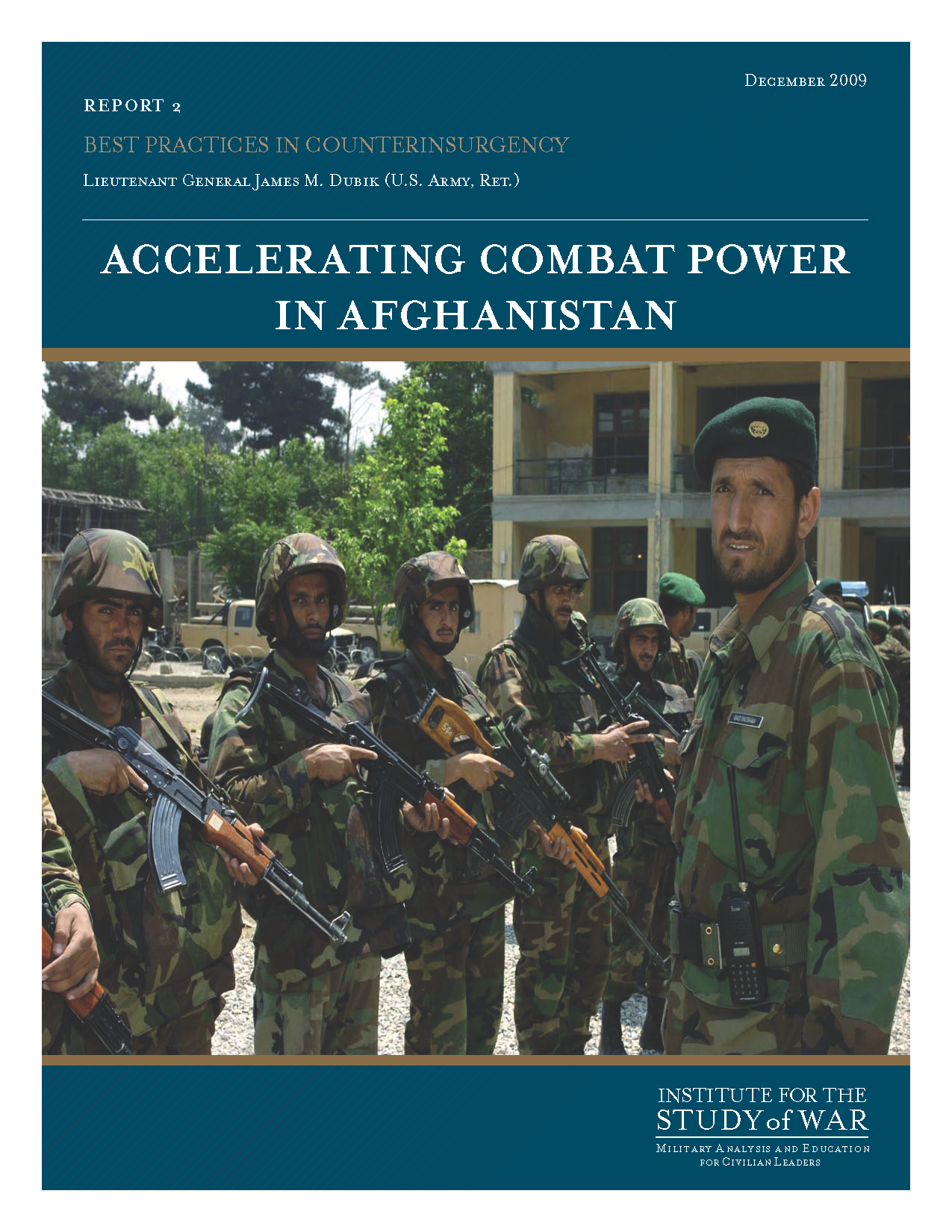 |
 |
Accelerating Combat Power in Afghanistan

Executive Summary
- Building foreign security forces is a challenge at any time due to political and cultural barriers, but it is even more so during active combat.
- Under my command, Multi-National Security and Transition Team – Iraq (MNSTC-I, pronounced “minsticky”) accelerated the growth of the Iraqi Security Forces (ISF)—military and police—by over 125,000 personnel. This rate of growth far exceeded any growth rate from previous years and, as the number of men in uniform grew dramatically, so did their capability and confidence.
- Although Afghanistan is not Iraq, some practical lessons for growing security forces during a conflict can be adapted to the unique circumstances in Afghanistan.
- Building indigenous military and paramilitary police forces while fighting is not just about numbers of individuals and units trained, equipped, and released onto the battlefield. Rather, building indigenous security forces while fighting requires one to focus on creating combat power that can be used effectively in battle and in providing security to the population.
- Combat power has two major components:
- First, having a sufficient number of sufficiently trained, equipped, and led military and paramilitary police forces.
- Second, those forces to be confident and capable enough to do what is expected of them relative to the enemy they face and the conditions in which they must succeed.
Size and Combat Power
- Any plan to accelerate the size of the Afghan National Security Forces will require increasing the Afghan training system’s “throughput capacity.” Throughput capacity can be expanded by:
- Building more training facilities.
- Expanding the size of existing training facilities.
- Increasing the number of training cycles per year.
- Compressing the training cycle by expanding the training day by several hours, training six or seven days a week, or eliminating unnecessary redundancies in training.
- In Afghanistan, there is currently the throughput capacity to generate and replace an army of about 90,000 and a police force of about 98,000. Any plans to grow these forces to 240,000 and 160,000, respectively, will require greater throughput capacity.
- As a temporary mitigating strategy, NATO Training Mission-Afghanistan (NTM-A)/Combined Security Transition Command-Afghanistan (CSTC-A) may be able to leverage vacant or under-utilized training facilities in nations near Afghanistan. Yet, the construction of more facilities within Afghanistan will be necessary to accelerate the growth of the Afghanistan National Security Forces (ANSF).
- NTM-A/CSTC-A will also be able to field more Afghan army and police by using a minimum essential combat equipping standard.
- Equipping the ANSF can be done iteratively, with an initial focus on the basic equipment associated with infantry and paramilitary police. Afghans can rely, in the short term, on NATO’s artillery, air support, medical evacuation, transport, and other combat multipliers.
- Over time, NTM-A/CSTC-A must go beyond the minimum in order to build a self-sufficient security force.
Confidence and Combat Power
- Confidence translates potential combat power latent in raw numbers of forces into actual, usable combat power.
- Accelerating confidence within an indigenous security force requires taking coherent and coordinated action at the tactical, operational, and strategic levels.
- At the tactical level, one must increase cohesion among soldiers and leaders, partner with Western forces, and ensure reliable access to combat multiplier systems.
- At the operational level, embedded trainers at the operational headquarters of the indigenous forces are necessary to accelerate proficiency, and thereby, confidence. Partnership at the operational level is likely even more effective than just embedded trainers.
- At the strategic level, developing competent and capable security ministries—ministry of defense, general headquarters, and ministry of interior—can accelerate confidence. Failing to do so can create a dependence upon the intervening force.
- The difference between local police and paramilitary or military forces has important practical consequences for those fighting a counterinsurgency or growing indigenous security forces during one.
- Military and paramilitary police forces impose order and are the proper organizations to clear insurgents from an area. Local police, who live and work in the same area, enforce order and cannot work effectively when insurgents dominate.
- The security imposed by military and paramilitary police forces sets the conditions for quasi-normal civic and economic life to emerge. These conditions are necessary before rebuilding the local police forces can begin in earnest.
- The difference between imposing and enforcing security suggests a priority of effort when building a security force during a fight.
- In general, the priority of development should go to military and paramilitary police units.
- This prioritization is consistent with the need to sustain momentum of a counteroffensive to secure the population against insurgents and to ensure that, when the population has been secured, there is a large enough and capable indigenous security force can begin to assume responsibility for internal security.
- Raising local police forces is not just a matter of training and equipping a set number of police. Rather, local police are a part of a set of enforcement systems: patrolling, investigations, forensics, apprehension, incarceration, logistics, facilities, training, leadership/management, and internal affairs.
- Growing local police forces requires: first, setting out the proper conditions with military and paramilitary police forces; second, establishing rudimentary police enforcement systems from local to ministerial levels; third, continuing the professionalization within those enforcement systems.
- In places like Iraq and Afghanistan, growing indigenous security forces—military, paramilitary police, and local police—is not an activity that can be understood separate from the overall counterinsurgency strategy. Rather, the effort to grow indigenous security forces is nested within the conduct of offensive and defensive operations to secure the population.
Tags
Full Size Image:
